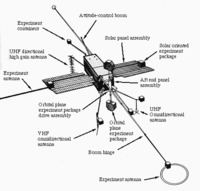Period 1964 – 1969 | ||
 | ||
Location Cape Canaveral Air Force Station, Florida, United States | ||
Orbiting Geophysical Observatory (OGO) refers to the six satellites launched by the United States that were in use from September 1964 to 1972, designed to study the Earth's magnetosphere. The satellites successfully studied the interactions between the Earth and the Sun, despite a number of technical problems. Each satellite had 20 to 25 instruments. OGO 1, OGO 3, and OGO 5 were in equatorial orbits; OGO 2, OGO 4, and OGO 6 were in lower polar orbits.
OGO launch chronology
References
Orbiting Geophysical Observatory Wikipedia(Text) CC BY-SA
